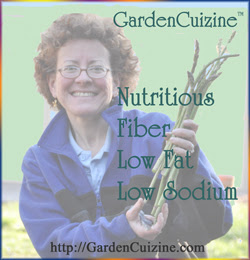Fiber, What About It?
I'm testing out recipes for a National Nutrition Month cooking class. Thanks to Serena Wolf's recipe inspiration, my family woke up to slow cooker Apple Pie Oatmeal made with steel cut oats, apples and ground flax, topped with a sprinkle of ground cinnamon, walnuts and pure maple syrup. Harry said it was the best oatmeal he ever ate! We sat around the breakfast table savoring the flavors of our oatmeal and the topic of fiber came up. Dietary fiber passes through our GI tract and supports digestion; but, fiber itself isn’t digested. Why do we need it then? For many reasons. 1) Fiber helps us feel full, keeping hunger in check. 2) Fiber helps regulate sugar in our body. 3) Fiber keeps our BMs regular. 4) Fiber helps lower bad cholesterol. 5) Fiber helps prevent some diseases.
Scientific research shows that high total dietary fiber intake is linked to a lower risk of coronary heart disease. Fiber benefits are also linked to helping breast cancer, IBS and diverticulosis.
How much Fiber do I need?
Adults and kids need between 20 and 35 grams of fiber every day. According to the National Institute of Health, most Americans are not meeting the recommendations and average 10-15 grams of fiber per day.
Aren’t there 2 kinds of Fiber?
Yes. Soluble and Insoluble
What’s the difference?
“What is an example of each?”
Soluble fiber attracts water like an absorbent paper towel. The more water it soaks, the moister it becomes – like a gel. Soluble fiber helps lower blood glucose and cholesterol.
Examples of foods containing soluble fiber include: oatmeal, barley, beans, nuts, seeds and fruit and veggies such as blueberries, prunes, citrus fruits, onions, avocado, Brussels sprouts, beets, broccoli and Jerusalem artichokes. Since soluble fiber absorbs water, adequate water intake is recommended as fiber intake increases.
Insoluble fiber keeps your BMs moving, helping to prevent constipation. You’ll find it in vegetables and whole grain foods like popcorn, wheat bran, wheat germ, Fiber One, whole wheat bread and brown rice.
Fiber comes from plants - many of which provide both types of fiber. Whole, natural foods are your best sources for dietary fiber.
- Vegetables
- Whole grains
- Fruits
- Legumes
- Nuts and Seeds
Easy Ways to Boost Fiber in Your Daily Diet
Fiber in Whole Grains
What is a Whole Grain
¿Que es un Grano Entero?
Top 5 Foods that can Lower LDL Cholesterol
Photo and Blog post Copyright(C) Wind. All rights reserved.





























No comments:
Post a Comment